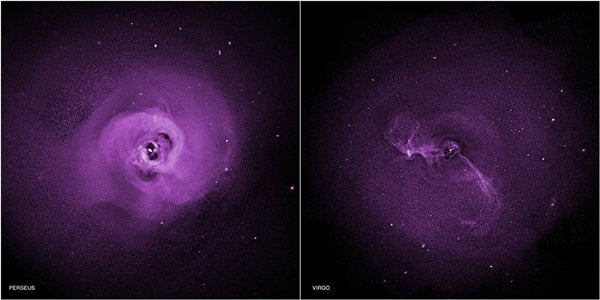We have all learned how plants and animals evolve over time, adapting and changing to better suit themselves to their environment. Well, the same things happen in much larger and grander proportions in space. Our Milky Way Galaxy is one of billions found in the observable universe, and an interesting phenomenon is that all galaxies evolve by changing shape, size, and color. Understanding the evolutionary processes of galaxies is one of the most important issues in astronomy and there are still fundamental problems to be solved. One approach is to study galaxy clusters that contain several thousands to tens of thousands of galaxies. Galaxy clusters are rich with hot intergalactic gas accompanied by strong gravitational forces. These clusters are the best location to observe environmental effects in galactic evolution.
To resolve the effect of the environment on the evolution of galaxies, a team of researchers from the National Astronomical Observatory of Japan and the University of Tokyo used Suprime-cam on the Subaru Telescope to observe the Coma Cluster of galaxies. The Coma Cluster contains more than 1,000 galaxies and is fairly close to Earth at about 300 million light-years away. The central portion of the cluster is inhabited by mostly elliptical galaxies, both dwarfs as well as giants.
During observations in 2006 and 2007, astronomers at Subaru discovered by chance a thread-like structure stretching from one of the galaxies. In this filament, extending from Galaxy RB199 for about 260,000 light-years, ionized gas surrounds many young stars that look like projectiles flying out from the galaxy. The research team called these knots “fireballs.” Detailed study identified several bright knots connected by blue filamentary structures, and the knots were found to be clusters of young stars weighing 10 million Suns and contained in an area about 3,000 to 6,000 light-years across. Because ionized gas accompanies the knots, active star formation is going on in the fireballs where usually far less star formation would be expected. The team noted that the size and the mass of the fireballs indicate they could develop into dwarf galaxies.
A question that developed during the study was what mechanism(s) stripped gas from Galaxy RB199 and created the fireballs? Because galaxies crowd the inside of the cluster, they pass by each other and crash into each other. The team thought that the tidal forces during such encounters could strip gas or stars from the galaxies. They also postulated that as a galaxy falls into the cluster’s center the gravitational forces could remove the gas and stars from that galaxy. The research team found these mechanisms could hardly explain the fireballs’ characteristics. The team then realized that ram pressure stripping occurs when superheated gas (several tens of million Kelvin) in the cluster and the galaxies collide at high speeds. Previous X-ray observation shows the presence of large amounts of hot ionized gas in the middle of the Coma Cluster while RB199 crashes into the center at a speed of 4,320,000 mph (6,952,366 km/h), causing strong friction with this hot gas. As such, the team concluded that the ram pressure has enough power to strip the gas from the galaxy and create the fireballs.
This study is the first to demonstrate that stripped gas turns into stars while traveling through remote space. While similar phenomena have been observed in galaxy clusters much farther away at several billion light-years, those distant cases were interpreted through witnessing the transitional phase of galaxies changing their morphology or colors as they fall into a cluster. The fireballs discovered by this team of Japanese astronomers provide the first sample of such structures in a nearby cluster. Principal investigator for the project, Dr. Michitoshi Yoshida said, “The team is confident that our study of these fireball phenomena leads to a better understanding of the gas stripping processes in galaxy clusters, and the effect of clusters on the evolution of individual galaxies.”










